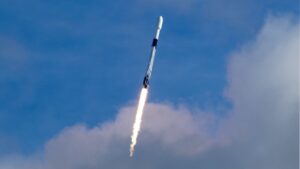24 that placed a world-record 143 satellites into orbit.
“Customer demand has been extremely strong. Demand is growing, so we’re certainly going to have some very full rockets coming up,” said Jarrod McLachlan, senior manager of rideshare sales at SpaceX.
He declined to speculate if those future rideshare missions might exceed the 143 satellites on Transporter-1, since it depends on the mix of customers and their payloads. He noted the company is seeing a trend to “slightly larger microsats” that might reduce the total number of satellites on those upcoming launches compared to Transporter-1.
Some customers, McLachlan said, are designing their spacecraft specifically to use those rideshare launches based on the size, mass and other interface requirements SpaceX publishes for those launches.
“We’re seeing some people who are optimizing their spacecraft and their constellation design around that volume, as well as some of the integrator/broker partners out there who are doing multiple spacecraft in a single port,” he said. “Being so public with our pricing and our requirements is really enabling people to be creative.”
The upcoming dedicated rideshare missions, like Transporter-1, will go to sun-synchronous orbit (SSO). That’s driven by customer demand for that class of orbits, McLachlan said. SpaceX also offers rideshare services to mid-inclination orbits by flying satellites as secondary payloads on Starlink launches. “If we see demand from something outside of SSO or mid-inclined orbits,” he said, “we’ll certainly take a look at that.”
While rideshare launches of smallsats on larger launch vehicles are not new, the scale of SpaceX’s effort, and its prices, have attracted widespread interest. That program is also seen as a major competitor for the growing number of small launch vehicle developers that can’t match the per-kilogram price SpaceX quotes for its rideshare customers.
Those companies are instead focusing on their ability to meet specific customer requirements not possible on rideshare missions, such as schedule and orbit. “To do that, you need different types of mission solutions, and that’s where Virgin Orbit comes in,” said Stephen Eisele, vice president at Virgin Orbit, on the panel.
Virgin Orbit successfully demonstrated its LauncherOne rocket on the company’s Launch Demo 2 mission Jan. 17. That mission placed 10 cubesats into orbit on a NASA-funded launch.
Eisele said the company is preparing for its next LauncherOne mission “in a few months,” estimating it to be in late in the first quarter or early in the second quarter of 2021. “We will take a little bit more time to analyze the data from our last Demo 2 launch,” he said, noting that the rocket for the upcoming mission is now in final integration.
That launch will carry payloads for the U.S. Air Force as well as a 6U cubesat for the Dutch air force, a contract announced Jan. 25. Eisele said the launch will also carry two 3U cubesats from SatRevolution, a Polish company developing a 14-satellite constellation to provide medium-resolution multispectral imagery. Virgin Orbit announced the deal with SatRevolution shortly before the panel Feb. 9, but did not disclose when the satellites would launch beyond later this year.
“We’re pleased to have them all on our next launch, and we look forward to continuing to provide a high cadence and flexibility going forward,” he said.
Rocket Lab also announced the manifest for its next Electron mission, scheduled for mid-March from New Zealand. That launch will carry seven satellites for a mix of government and commercial customers, including Rocket Lab’s second Photon satellite. The Photon will test technologies needed for the launch later this year of NASA’s CAPSTONE lunar spacecraft, which will use Photon as a kick stage.
“We’re over 90% booked on both our launch and our space systems division” for this year, said Peter Beck, chief executive of Rocket Lab, during the conference panel.



